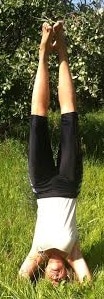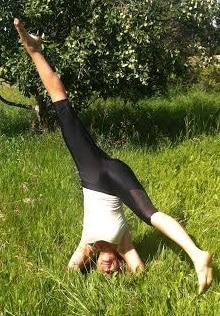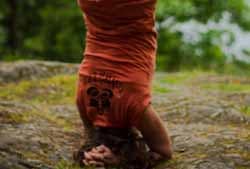Subm itted by Sarah Trombetta, SOYA 200 hour teacher in Ft. McMurray.
itted by Sarah Trombetta, SOYA 200 hour teacher in Ft. McMurray.
Starting in child’s pose, take a couple of breaths. Then sit up on your heels. Make a firm foundation to support your body by placing the forearms on the floor. Grab each elbow with the opposite hand to ensure elbows
are the correct distance apart. Interlock the fingers and keep the elbows beneath the shoulders. Now you have created a firm triangle foundation with the forearms.
- Place the top of your head on the floor with the back of the head firmly against the clasped hands. Tuck your toes under, straighten the knees and raise the hips up to form an inverted V shape. Keep pressing into the forearms and walk your feet towards the head until your hips are over the head, or as close as is possible.
- If you are able to, press your forearms into the floor and use your abdominal strength and lift the feet off the floor and bring the knees into the chest. Slowly straighten the legs and bring the feet up toward the ceiling. Keep 2/3rds of the body weight on the forearms and only 1/3rd the body weight on your head. Hold the headstand for 5-10 breaths.
- To come out of the position use your abdominal muscles to slowly bring the knees back towards the chest, then bring the feet to the floor and relax into the child’s pose. Do not sit up too quickly to prevent dizziness or a headache.
Benefits:
Helps to increase balance. Gives relief to varicose veins by taking the weight off the legs. Increases circulation to the spine, the brain and heart. Tones the endocrine glands. Rejuvenates the entire body increasing energy and vitality. Abdominal organs are relieved from constant pressure and with the inversion it stimulates those that are sluggish. Blood vessels can contract fully. The heart does not need to exert itself so pumps slowly and can rest.
Precautions and modifications:
Do not do if you have glaucoma or whiplash or a detached retina. Do a mild inversion instead, such as legs up the wall.
If you have anxiety or fear doing this inversion, use a wall with an assistant to help support you.
If you have weak wrists difficulty keeping your elbows under the shoulders (they tend to spread apart) then use a strap to keep them the correct distance apart.
For neck injuries or weakness in the upper body strength, do only phase 1. This is known as ardha sirsasana or the dolphin pose. Holding this pose will help you to build upper body strength without compromising the neck and head.
Advanced variations:
 While in the headstand, you can stretch the feet wide apart to the side and to the front/back.
While in the headstand, you can stretch the feet wide apart to the side and to the front/back.
You can drop one leg down towards the floor while keeping the other leg up, then raise the leg back up and repeat with the other leg.
Lower both legs down towards the floor and raise back up again. With legs extended, twist them to the right and then to the left.


Recent Comments